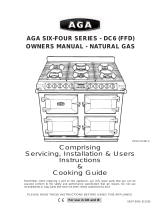Cooker Hoods and Oven Venting
The use of a gas cooking appliance results in the
production of heat and moisture in the room in which it
is installed. Ensure that the kitchen is well ventilated,
keep the natural ventilation holes open or install a
mechanical ventilation device (mechanical cooker hood).
It is recommended that this AGA is fitted with a cooker
hood above it. The AGA venting system is located on
top of the AGA and is designed for venting the moisture
from the ovens. The cooker hood should be positioned
not less than the minimum height as recommended by
the manufacturer, from the top of the AGA.
Prolonged intensive use of the appliance may call for
additional and/or more effective ventilation, for example,
opening of a window, or, increasing the level of
mechanical ventilation where present.
The AGA City60 ovens are manufactured from cast iron,
over a period of time they will become individually
seasoned.
However, the ovens will rust if high moisture content
foods are not covered (especially in the Simmering
Oven) or spillages are not cleaned up.
It is also not advisable to leave a full or partially filled
saucepan/utensils with high moisture content food in the
ovens when they are not in use.
To season the ovens a light vegetable oil is ideal (corn
oil is best). A spray oil is recommended. Any stubborn
stains can be removed with the wire brush supplied.
Please refer to Page 21, for Cleaning of Ovens.
General Advice
10
Food SHOULD NOT be placed into any oven until the
oven is up to normal operating temperature.
The oven doors should not be left open for long periods
of time during cooking and heating up.
Store the cold plain shelf outside the cooker. Use it cold
in the Roasting Oven to deflect heat from the top of the
oven, creating a more moderate oven temperature
underneath. It can also be used as a baking sheet.
Do not store the roasting tins or the cold plain shelf in
the ovens.
Warm up times
As the AGA works on the principle of storing heat, time
is required to gather that heat from the electric elements
to saturate the castings. We recommend to allow an
hour heat up time. The optional programmer is a great
asset as it can be set to get the top oven to its working
heat, ready for you to cook when you walk through the
door.
The principle of heat storage means that the ovens are
at a pre-set heat, the cooking areas are named after
their function rather than temperatures.
For recipes refer to your generic AGA book supplied
with your cooker.
Using the Zones of the
AGA City60
The different zones of the AGA City60 cooker are
described individually, in the following pages.
The traditional AGA heat storage cooker is famous for
the gentle warmth it emits, with the AGA City60 you will
get warmth only when the cooker is on or warmth to a
lesser degree when only parts of it are on.





















